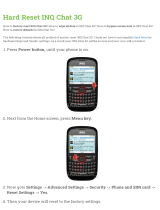
2
Table of Contents
Overview
Main Features ........................................................ 3
System Components .............................................. 4
Connection Diagram ............................................. 5
Location and Function of Parts and Operation .. 6
Front/Top/Bottom ............................................... 6
Rear .................................................................... 6
Installation ............................................................. 7
Fitting the lens .................................................... 7
Using a tripod ..................................................... 7
Connecting the camera cable ............................ 7
When power supply from the IEEE1394b
connector is insufficient ................................... 7
Notes on Operation ................................................ 8
Phenomena Specific to CCD Image Sensors ....... 8
Functions
Gain ........................................................................ 9
Shutter .................................................................... 9
Absolute Value Control for the Shutter ............... 9
Auto Exposure ..................................................... 10
Gamma ................................................................. 10
Lookup Table ....................................................... 10
3 × 3 Image Filter ................................................ 10
Trigger .................................................................. 11
Pan/Tilt ................................................................. 12
Brightness ............................................................. 12
Sharpness (Black and white models only) ......... 12
Saturation (Color models only) .......................... 12
White Balance (Color models only) ................... 12
Hue (Color models only) ..................................... 12
Trigger Delay ....................................................... 12
GPIO ..................................................................... 12
Strobe Control ..................................................... 13
Setting AE/AWB Control Frame and Parameters
................................................................................ 13
Test Charts ........................................................... 13
Changing Bayer Patterns (Color models only) . 13
Trigger Inhibition ................................................ 13
User Free Memory ............................................... 13
Memory Shot ....................................................... 14
Broadcast Command ........................................... 14
1394 Bus Synchronization .................................. 14
Partial Scan .......................................................... 15
Binning Mode ....................................................... 16
Format7 Mode4 for XCD-V60/V60CR .............. 16
16-bit Mode .......................................................... 16
Control
Camera Command Status Register ....................17
ConfigurationROM ..............................................18
Control Base Address ..........................................20
Inquiring about Supported Video Modes ..........20
Video Mode Settings (S800) ................................21
Video Mode Settings (S400) ................................21
Starting/Stopping Video Transfer
(ContinuousShot) .................................................21
OneShot and MultiShot .......................................21
Control of IIDC Standard Features ...................22
The formula for absolute value shutter control
register address ...............................................25
Control of IIDC Optional Features ....................26
Control of Sony’s Unique Features ....................27
LUT (LookUp Table) ........................................27
3 × 3 Filter ........................................................28
Display of Test Chart ........................................28
Trigger Inhibition ..............................................29
User Free Memory ............................................29
Setting AWB (Auto White Balance) Parameters
.........................................................................30
Setting AE (Auto Exposure) Parameters ..........30
Memory Shot ....................................................31
Notes on the Camera Operations .......................32
If Frame Rate Decrease Occurs ........................32
When Using Trigger Mode ...............................32
On Sensitivity in Binning Mode .......................32
Auto Shutter Control and Absolute Value Shutter
Control ............................................................32
On Accuracy of Auto White Balance ...............32
Specifications
Specifications ........................................................33
Video Modes Supported ......................................34
Appendix
Spectral Sensitivity (Relative Response)
Parameters ............................................................36
Dimensions ............................................................38





















